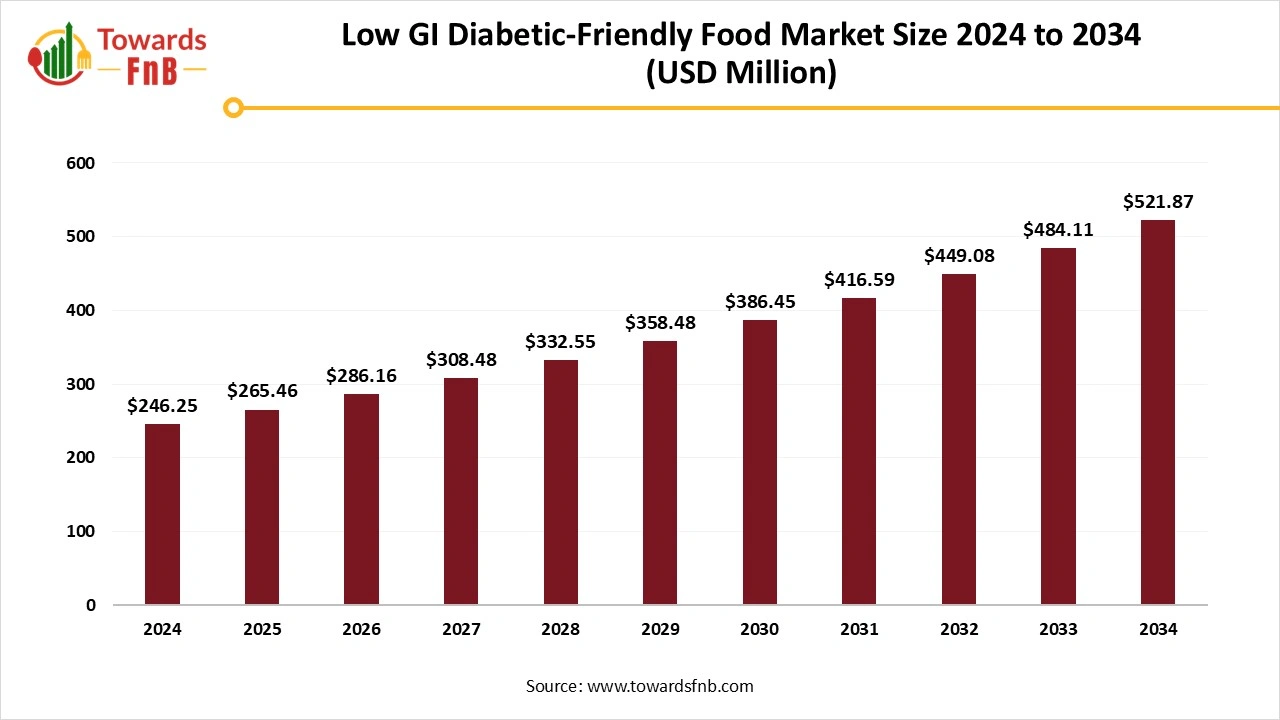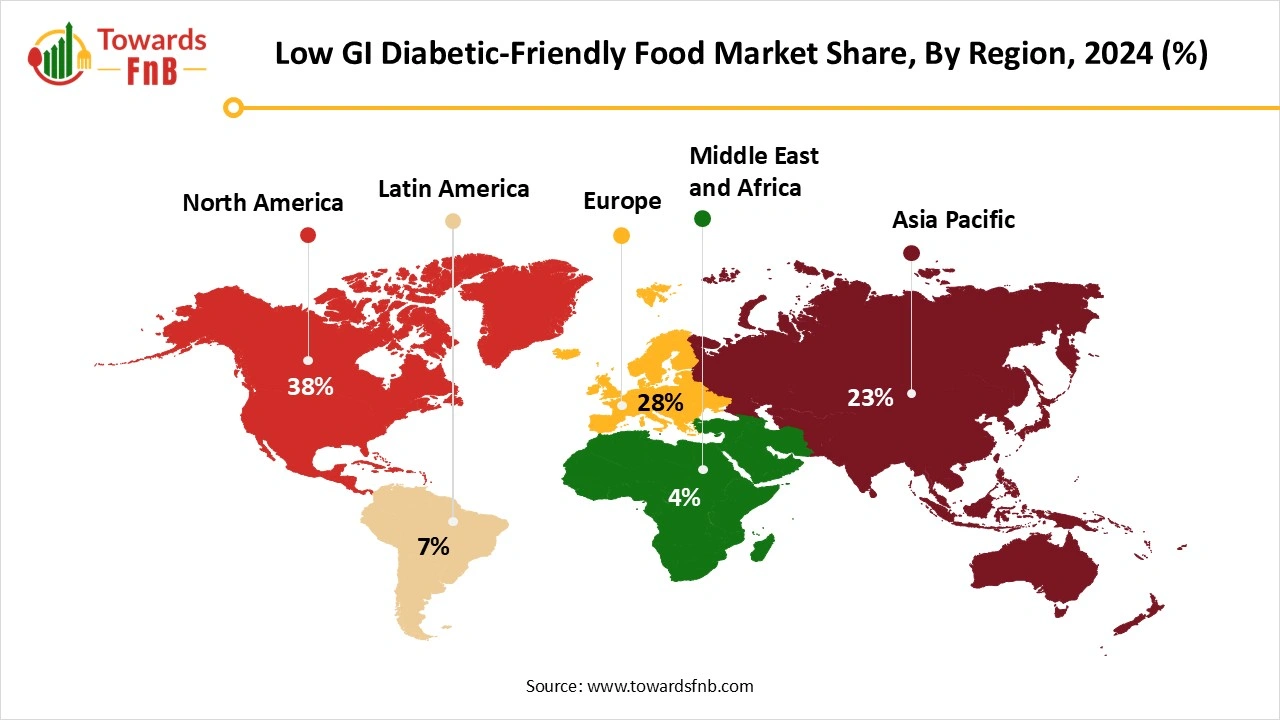December 2025
The global low gi diabetic-friendly food market size was valued at USD 246.25 million in 2024 and is expected to grow steadily from USD 265.46 million in 2025 to reach nearly USD 521.87 million by 2034, with a CAGR of 7.8% during the forecast period from 2025 to 2034. The increased need of diabetes patients to improve blood sugar control and enhance insulin sensitivity raises the importance of consuming food with a low glycemic index.

| Study Coverage | Details |
| Growth Rate from 2025 to 2034 | CAGR of 7.8% |
| Market Size in 2025 | USD 265.46 Million |
| Market Size in 2026 | USD 286.16 Million |
| Market Size by 2034 | USD 521.87 Million |
| Largest Market | North America |
| Base Year | 2024 |
| Forecast Period | 2025 to 2034 |
| Regions Covered | North America, Europe, Asia-Pacific, Latin America, and Middle East & Africa |
The low gi diabetic-friendly food market encompasses food products specifically formulated or naturally suited to help maintain stable blood glucose levels. These foods release glucose more gradually into the bloodstream, making them suitable for individuals with diabetes or insulin resistance. The market includes a wide range of items such as grains, sweeteners, snacks, dairy, beverages, and ready meals, designed to be both health-conscious and appealing to diabetic and pre-diabetic consumers.
Nutritional Supplements and their Health Benefits
| Sr. No. | Name of the Supplement | Potential Health Benefits |
| 1 | Omega-3 fatty acids | To reduce inflammation To promote heart health To improve lipid profiles |
| 2 | Vitamin D | To support immune function and bone health To improve insulin sensitivity |
| 3 | Chromium | To enhance insulin sensitivity To increase glucose metabolism |
| 4 | Alpha-lipoic acid | To deliver antioxidant activity To manage diabetic neuropathy To reduce insulin resistance |
(Source: Diabetes Resource Coalition of Long island)
Several technologies have introduced revolutionization in diabetes care and nutrition management. These advancements include wearable devices, mobile applications, personalized meal plans, virtual coaching, tracking tools, etc. With the growing use of these technologies, diabetes patients are receiving better assistance with real-time feedback and reminders. They also encourage patients to meet their specific dietary goals by tracking the intake of carbohydrates, using intuitive interfaces to easily log their meals, and monitoring blood sugar levels, which empowers them to make informed decisions about food choices.
The high production costs are associated with diabetic products such as low glycemic sweeteners and dietary fibers. It is challenging convincing diabetic food consumers about the good tasting features of diabetic-friendly food products along with their benefits in controlling blood sugar levels. There are some regulatory constraints associated with stringent food labeling regulations and health claims on diabetic foods which create barriers for some food manufacturers.
North America dominated the low GI diabetic-friendly food market in 2024 owing to the development of new diabetic-friendly products and the growth of e-commerce. The International Food Policy Research Institute situated in Washington D.C. reported food systems for healthy diet and nutrition in its recently published paper entitled ‘Global Food Policy Report’ 2024. The IFPRI provides research-based policy solutions to reduce poverty, hunger, and malnutrition in low-and middle-income countries in a sustainable manner.
A consumer-oriented food systems framework supports sustainable healthy diets through various favorable measures. These supportive driving forces include systems supporting food production, food supply chains, consumer behaviors, consumer characteristics, diets, nutrition and health status, and other food systems. All these major driving forces encourage growth and innovation at biophysical, environmental, technological, economic, political, institutional, sociocultural, and demographic levels.

How Crucial is the Role of Diabetes Food Hub in the U.S.?
The American Diabetes Association provides guidelines on eating healthy and delicious food along with tips regarding healthy eating. It also empowers people about the impact of food on blood glucose and reading food labels. The White House is making efforts to resolve the challenges to end hunger and build healthy communities. The White House made commitments through two initiatives which include ABOUT FRESH, FRESH CONNECT PROGRAM and ABOUT FRESH, FRESH TRUCK. About Fresh, fresh connect program made a $60 million investment for 5-years to implement and utilize necessary data to boost food prescription research at leading food research centers. About fresh, fresh truck program made a $2.2 million investment for 3-years to support local farmers and make strong connections with neighbours.
Asia Pacific is expected to grow at the fastest CAGR in the low GI diabetic-friendly food market during the forecast period.
Due to product innovations and the development of low GI products based on dietary preferences of consumers. In December 2024, the International Rice Research Institute (IRRI) and the Max Planck Institute reported that the scientists at these research organizations are making efforts to explore the potential health benefits of rice having a low glycemic index (low GI) to resolve diabetes epidemic challenges in the Asia Pacific. It also stated that type 2 diabetes is one of the rising global health challenges in the Asia Pacific which is estimated to increase 780 million by 2045. A high consumption of calorie-dense sugary drinks, refined carbohydrates, ultra-processed food, polished white rice, and staple food are linked to the rising glycemic load and increased prevalence of acute diabetes in the Asia Pacific region.
What are the Proactive Measures by the Government of India to Tackle Diabetes?
In November 2024, the Ministry of Health and Family Welfare celebrated the World Diabetes Day which paid attention on spreading the global awareness about diabetes and addressing significant health challenges related to diabetes globally. The Department of Health and Family Welfare also focuses on the emerging needs for early diagnosis, diabetes prevention, effective diabetes management, and equitable care access. It is committed to overcome issues in diabetes care and ensure equal access to high-quality and affordable treatment through the theme of 2024 entitled ‘Breaking Barriers, Bridging Gaps’. (Source: Department of Health & Familt Welfare)
How Low GI Grains & Cereals Segment Dominated the Low GI Diabetic-Friendly Food Market in 2024?
The low GI grains & cereals segment dominated the low GI diabetic-friendly food market in 2024 owing to the benefits of grains and cereals having low glycemic indices. They help consumers to achieve control over their blood sugar levels, manage weight, and live with improved energy levels. They reduce the risk of developing heart disease by improving heart health and digestive health. They serve as the powerhouses of nutrients in the form of low GI grains like millets enriched with essential vitamins, B vitamins, and minerals, which contribute to overall health and well-being. Consumers are choosing low GI grains like quinoa, oats, millets, barley, and buckwheat as the foundation of their diets.
The low GI ready-to-eat meals segment is expected to grow at the fastest CAGR in the market during the forecast period, due to the convenience of pre-made options for people looking to adopt low GI diets. These ready-to-eat meals offer benefits such as timesaving, reduced food waste, portion control, and variety.
What made Type 2 Diabetics the Dominant Segment in the Low GI Diabetic-Friendly Food Market in 2024?
The type 2 diabetics segment dominated the market in 2024 owing to the reduced risk of diabetes complications and the potential for reduced need for insulin. Low GI foods contribute to a reduced risk of cardiovascular complications and enhanced insulin sensitivity. They enhance energy and mood and improve overall health. These low GI foods help to maintain blood sugar spikes after meals and benefit people with insulin resistance. They help to prevent risks of nerve damage, eye problems, and kidney damage.
The pre-diabetics & fitness consumers segment is expected to grow at the fastest CAGR in the low GI diabetic-friendly food market during the forecast period, due to the benefits of low GI foods for fitness consumers. These foods help them with fat burning, improve performance, and reduce the risk of hypoglycaemia.
How did the Supermarkets/Hypermarkets Segment Dominate the Low GI Diabetic-Friendly Food Market in 2024?
The supermarkets/hypermarkets segment dominated the market in 2024 owing to the availability of low GI foods at the grocery store. The availability and accessibility of various types of food products with low GI, such as whole grains, fruits, non-starchy vegetables, legumes, dairy products, nuts, seeds, and lean proteins at the grocery store enables buyers and consumers to make informed food choices. These stores enable diabetic patients to look for food products with high nutritional value that are enriched with fat, protein, and fiber content. The low GI food products offered by these stores are rich in fiber, healthy fats, and antioxidants, which are beneficial for heart health. The supermarkets are focused on offering essentials, while hypermarkets serve as a one-stop solution to meet a broad range of consumer needs.
The online retail/direct-to-consumer (D2C) segment is expected to grow at the fastest CAGR in the low GI diabetic-friendly food market during the forecast period, due to the benefits of these businesses. They are popular due to their brand identity, improved customer experience, and global supply chain. The online retail or D2C channels facilitate seamless returns and exchanges, faster delivery, and personalized experiences. There is a great access to reviews and information, better prices and discounts, wider selection of products, and convenience. They also allow easy scalability, faster innovations, and expanded market reach. They achieve increased control over their pricing, branding, marketing strategies, and the entire customer experience. They present higher profit margins and direct customer relationships.
How High-Fiber Whole Foods Segment Dominated the Low GI Diabetic-Friendly Food Market in 2024?
The high-fiber whole foods segment dominated the low GI diabetic-friendly food market in 2024 owing to the benefits of a high-fiber diet focusing on whole foods. These foods help consumers with improved digestive health, heart health, blood sugar control, and weight management. They enhance the gut microbiome, reduce the risk of certain chronic diseases, and improve longevity. The fiber-enriched foods promote regular bowel movements and reduce the risk of diverticular disease and hemorrhoids. They also reduce the risk of premature death caused by heart disease and cancer.
The sugar substitutes/ alternative sweeteners segment is expected to grow at the fastest CAGR in the market during the forecast period.
Due to their potential for dental health and reducing the overall sugar intake. Sugar substitutes are becoming a popular choice among consumers due to the presence of few or no calories. They help to manage weight loss and maintain healthy weight. There is a reduced risk of tooth decay and cavities due to the intake of sugar substitutes which also prevent plaque formation. There are expanded food choices for consumers and these alternative sweeteners are cheaper than sugar. They minimally impact on blood sugar levels, and they can potentially lower blood sugar and insulin response.
Unilever

By Product Type
By End-Use Consumer Group
By Distribution Channel
By Ingredient Profile
By Region
December 2025
December 2025
December 2025
December 2025